To this point we’ve cleaned, resized, trimmed, and primed our rifle brass. Now it’s time to charge it with smokeless powder!
Disclaimer
Ultimate Reloader LLC / Making with Metal Disclaimer: (by reading this article and/or watching video content you accept these terms). The content on this website (including videos, articles, ammunition reloading data, technical articles, gunsmithing and other information) is for demonstration purposes only. Do not attempt any of the processes or procedures shown or described on this website. All gunsmithing procedures should be carried out by a qualified and licensed gunsmith at their own risk. Do not attempt to repair or modify any firearms based on information on this website. Ultimate Reloader, LLC and Making With Metal can not be held liable for property or personal damage due to viewers/readers of this website performing activities, procedures, techniques, or practices described in whole or part on this website. By accepting these terms, you agree that you alone are solely responsible for your own safety and property as it pertains to activities, procedures, techniques, or practices described in whole or part on this website.
Powder Selection and Safety
Researching load data for your cartridge is important for the ultimate success of your handloaded ammunition. The first step is defining goals for your ammunition. Is it for formal target shooting? Long range? Is it just “blasting” ammo? Is it for hunting? If so, big game, varmints or something else?
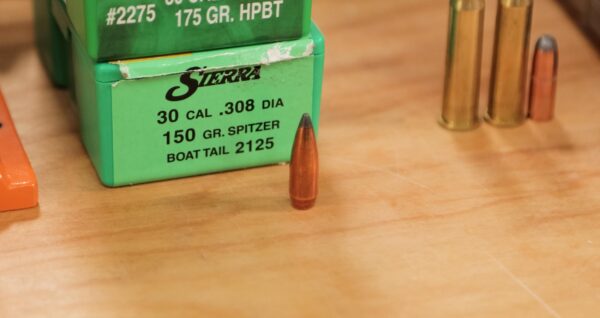
For this series, I’m loading 308 Winchester for deer hunting with a 150 grain Sierra SPBT GameKing bullet. I want good accuracy and decent velocity. A maximum level load probably isn’t necessary, but good velocity is important.
There are numerous suitable powders for such a load! For instance, when I went to Hodgdon’s online Reloading Data Center, I found 87 different loads for the 308 Winchester with a 150 grain bullet. To make your choice, I recommend consulting several different sources and cross-checking them. At least one major reloading manual has been published with the wrong load data! To that manufacturer’s credit, they quickly issued a correction, but it’s still prudent to verify load data.
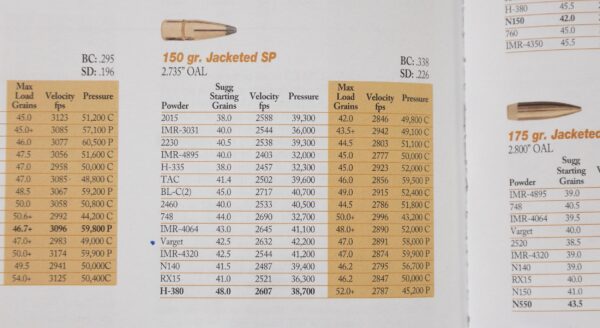
Reliable load data is typically provided by both powder manufacturers/distributors and bullet manufacturers. When coming up with a new load, I typically start with Hodgdon’s online Reloading Data Center, which now includes data for Ramshot and Winchester powders. Hodgdon also prints an Annual Manual which has much the same data, along with several pertinent reloading articles by respected gun writers. Alliant has their own online data.
Reputable magazines such as Handloader, Guns & Ammo and others often provide load data as well.
It’s important to update load manuals from time to time. Powders become unavailable and sometimes change over time. In addition, pressure testing of loads has changed and become more sophisticated over time, sometimes resulting in changes to recommended powder charges. What may have been thought to be a safe load decades ago may not be considered so safe today.
Data from bullet manufacturers is also worth a look.
Load data isn’t necessarily interchangeable from one bullet to another, even if they’re the same diameter and weight. For instance, I found the recommended powder charge for Hornady’s ELD-X hunting bullet may be too “hot” for the same weight Hornady CX because of their dramatic differences in bullet construction.
On my loading bench I have manuals from Hodgdon, Lyman, Hornady, Speer, Barnes, Sierra, Nosler, Berger and RCBS. Between those and the internet, I’m able to safely produce quality ammunition for a wide variety of cartridges and for different purposes.
Use the utmost caution when considering load data found on reloading forums and discussion pages. Some is reliable, some is not. It is always best to verify all loads with another reputable source.
A word about maximum loads. These are loads which the publisher of the data considers safe to use if properly worked up to. Historic practice is to start with low-end loads and “work up” towards the maximum, or towards the level you’ve selected. This method is timeless. There is nothing wrong or dangerous with using maximum level loads IF they’re properly worked up to.
In this series, we’re loading .308 Winchester with a 150 grain Sierra GameKing bullet and Hodgdon powder. I’ve loaded and fired thousands of 308 Winchester rounds, enough to wear out several barrels at 4,000 to 6,500 rounds each. I primarily used Varget and 165 or 168 grain bullets.
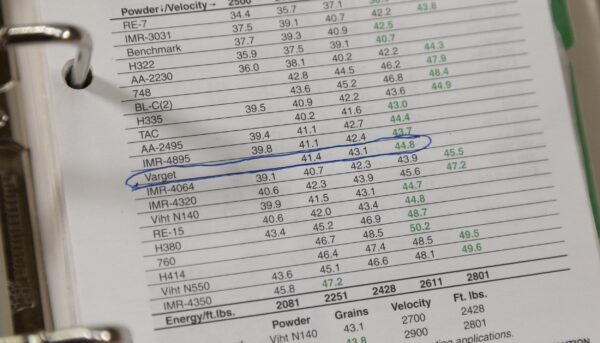
My older Sierra manual lists a minimum load of 41.4 grains and a maximum load of 44.8 grains of Varget with their 150 and 155 grain bullets.
Hornady shows Varget charges of 35.9 grains to 44.9 grains for their 150 to 155 grain bullets.
Nosler shows Varget charges of 42.5 to 46.5 grains for their 150 to 155 grain bullets
Hodgdon shows Varget charges of 44.0 to 47.0 grains of Varget for the similar 150 grain Nosler Ballistic Tip bullet.
As evidenced above, there are differences between the different sources, all of which are reliable.
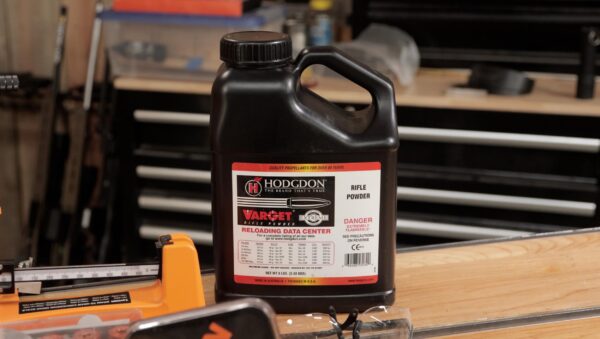
It pays to start with a lower charge and work up carefully. With a cartridge of the 308’s size, I typically work up a grain at a time, watching for pressure signs. As the charges get close to maximum, I’ll reduce that increment from 1 grain down to a half grain or less. You do not have to work up to maximum. You may find a node with good accuracy and your desired velocity at a charge less than maximum.
There are two different ways manuals show pressure. One is psi, pounds per square inch. The other is CUP, copper units of pressure. These are not the same and are not interchangeable. One thing I particularly like about Hodgdon’s manual and online source is they specify how much pressure you’re getting from the low-end load to the high-end load.
Burn Rate
Powders are ranked in order of “burn rate.” The fastest burning powders start with 1 (Norma R1). The slowest burning powder shown is 172 (Vihtavuori 20N29).
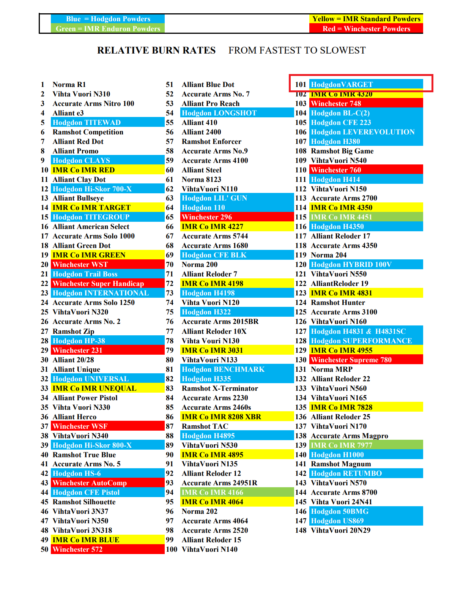
In rifle reloading, the fastest burning powders are typically used in small charges for light loads while the slowest burning powders are intended for high velocity magnum cartridges. The 308 Winchester works well with a wide range of powders, starting around number 83 on the chart (Accurate 2015BR) and up to about number 115 (Hodgdon Varget). This is a general guide only. Specific load info should come from a published load manual.
Double Charges
Caution! Double charges can happen! It occurs most frequently with handgun cartridges, but can happen with rifle charges if using a light charge of quick burning powder which doesn’t take up much room in the cartridge case. A double charge of powder can destroy a firearm and severely injure the shooter.
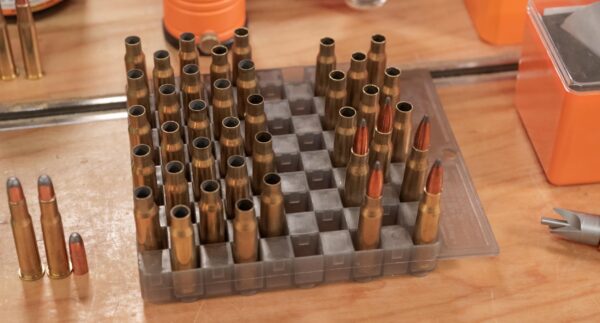
To avoid a double charge, choose a powder that nearly fills the case to capacity, and visually check each cartridge case after it’s been charged. A double charge will stand out easily.
One Powder at a Time
On the loading bench, keep things well organized. For safety, there should be only one type of powder on the bench at a time. Many powders have a similar appearance, but very different burn rate characteristics. It can be dangerous to mix them or use the wrong powder! Gavin and I often have multiple reloading projects going on at once and we label the powder measure conspicuously with the type of powder contained. This helps tremendously if we have to stop a project and get back to it later.
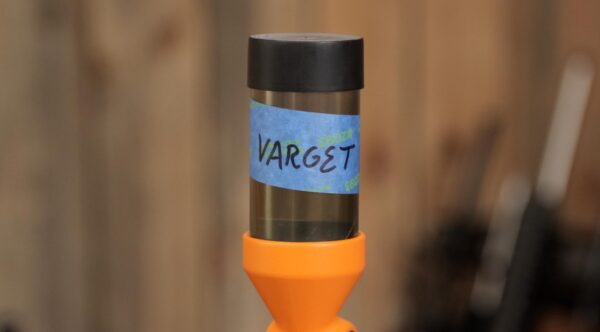
Typically, I’ll extend this method to all other components on my loading bench. One project at a time, one type of cartridge case, one bullet, one primer and of course one powder — only what’s being used for that particular loading project. If I’m finished with a project, I’ll put the powder back in its appropriate container.
Visual Powder Check
Typically I load on a single stage press or a turret press. Occasionally I load on a progressive press. A visual powder check can be done a couple of different ways.
If I charge all the cases before beginning to seat the bullets, I put all of the charged cases in a loading block and use a flashlight to look at the entire lot of charged cases. A double charge or an empty case will stand out.
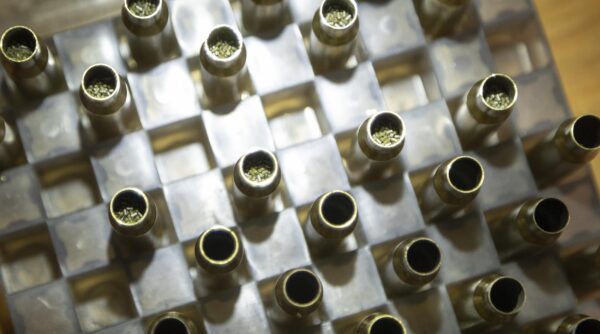
If I’m loading on a turret press, I may charge a case then immediately seat a bullet. If so, I pause and take a look at the freshly charged case to see the powder charge before seating the bullet. This can also be done on a progressive press. It slows the rate of production a bit, but ensures every case is properly charged.
Charging the Case
For this series, we used a few different Lyman products — the Brass Smith Powder Measure mounted on their powder measure stand, Brass Smith 500 Metal Reloading Scale and powder trickler.
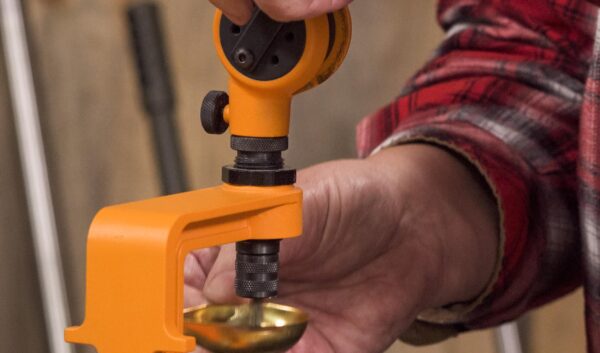
Gavin already reviewed the powder measure, and I’ve been using the Lyman Brass Smith reloading gear quite frequently at home, loading for various rifles and handguns from 223 up to 375 H&H and 45-70. I really like that the body of the Brass Smith powder measure lifts off. This makes it extremely easy to pour the remaining powder back into its appropriate container. It comes standard with a baffle that helps you throw more consistent powder charges. I can also adjust the angle of the measure in the stand.
The charging procedure is as follows:
Zero the balance scale on a level work surface.
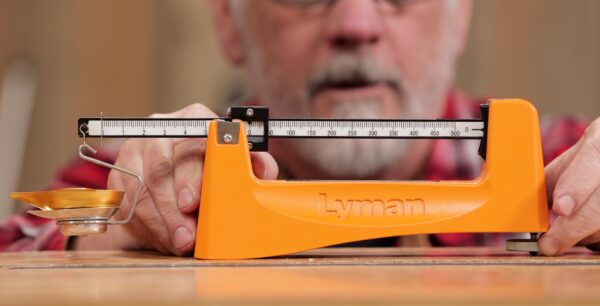
Positioning it close to eye level is helpful. Once zeroed, set it at the desired charge weight. I use balance beam scales about as often as electronic scales. Both are viable options.
Fill the powder trickler with the powder to be used, in this case Varget.
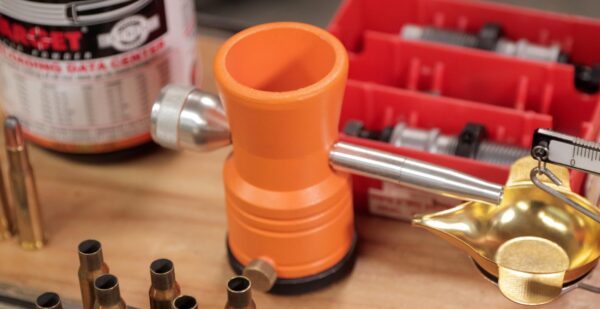
Fill the hopper of the powder measure with the same powder of choice.
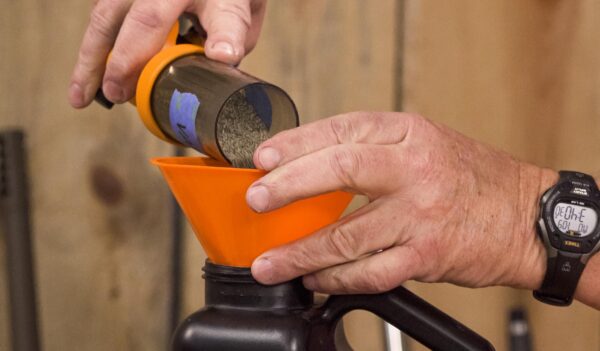
The Lyman Brass Smith powder measure has both a coarse and a fine adjustment, allowing for larger or smaller adjustments.
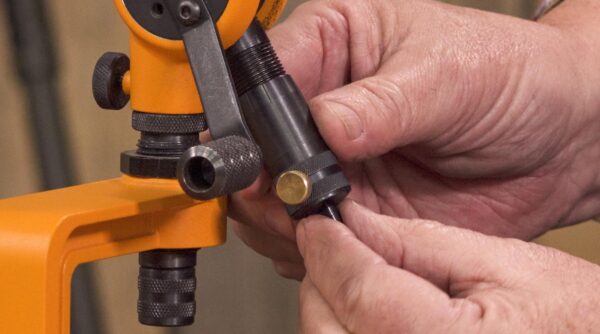
Adjust the rod of the powder measure to get close to the desired powder charge. The further out the rod is, the more powder it dispenses. Use the dial to fine tune the powder measure. For this project, I landed on 44.5 grains of Varget. It may take a little bit of time to properly adjust the powder measure, but once it’s set it’s set. When I got close to 44.5 grains on the powder measure, but not over, I turned to the powder trickler.
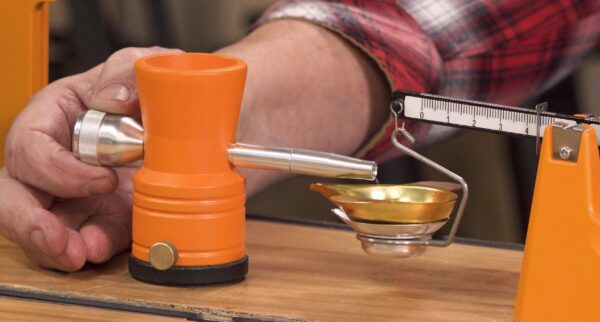
Note that if a large stick extruded powder is used, the measure may not throw charges with great accuracy. This is where the powder trickler comes in. Set the measure to throw a grain or so under the desired weight, then use the trickler to bring the charge weight up to the desired level.
If a fine powder, such as a spherical powder or one with small sticks of extruded powder, the measure will throw more accurate charges.
It’s up to the handloader to determine if each charge should be weighed or just thrown from the measure. This depends on the level of accuracy required and on the type of powder used. Many match shooters use a progressive press, which simply throws the charge, so even that can produce good accuracy.
A funnel should be used to fill the cartridge case with each charge of powder. For this story, I used the Lyman Brass Smith Precision Funnel Set.
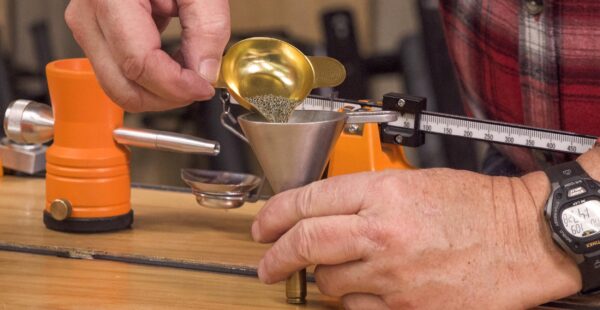
The advantage of this funnel is it fits the case mouth, instead of being a one-size-fits-all type of funnel. Pour the powder gently into the funnel, giving it time to gradually fill the cartridge. This makes it easier to get larger powder charges into the case. Sometimes a drop tube may be necessary to fit large quantities of powder into the case.
Once the case has been charged with powder, it’s ready for the next step, seating the bullet.
Conclusion
Watch for the next installment in our basic rifle reloading series covering bullet seating and crimping!
Get the Gear
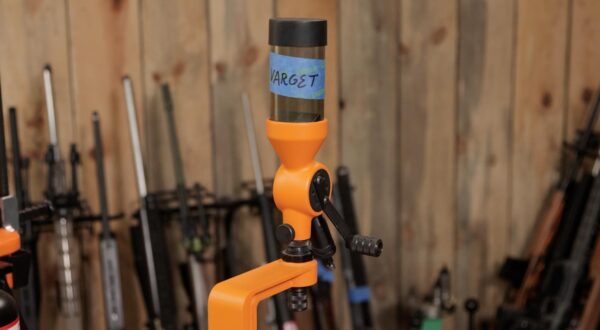
I’m well aware Varget is currently difficult to find. Many powders are. This just means doing more research to find out if what’s available will meet your needs!
2023 Annual Manual at Midsouth Shooters Supply
Lyman 51st Edition Reloading Handbook
Berger Bullets Reloading Manual at Midsouth Shooters Supply
Hornady® 11th Edition Handbook of Cartridge Reloading
Hodgdon Varget at Midsouth Shooters Supply
Don’t miss out on Ultimate Reloader updates, make sure you’re subscribed!
Thanks,
Guy Miner

















































































